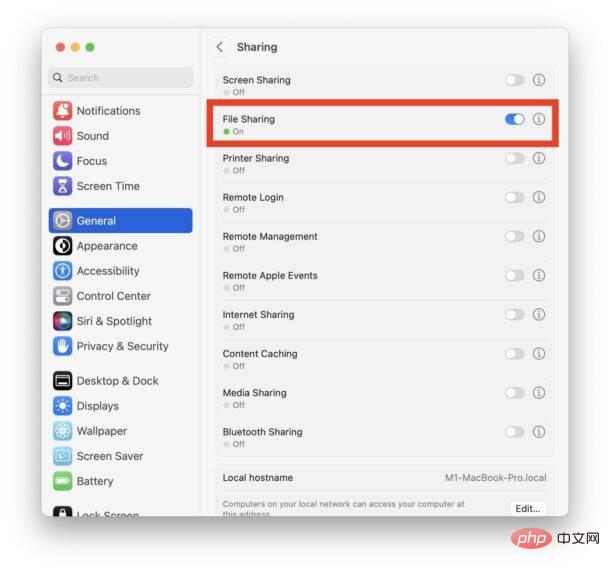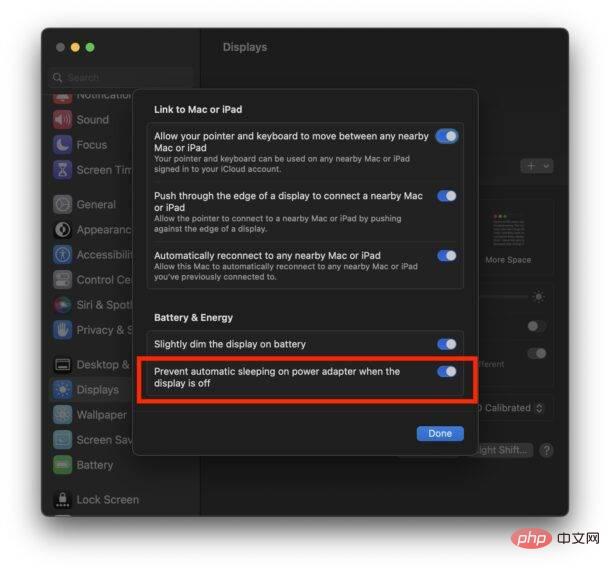 System Tutorial
System Tutorial MAC
MAC Mac capitalization conversion shortcut key (which is the mac capitalization conversion shortcut key)
Mac capitalization conversion shortcut key (which is the mac capitalization conversion shortcut key)php editor Yuzai today introduces to you the uppercase conversion shortcut keys in the Mac operating system. When using a Mac computer, we often need to switch between upper and lower case, and using shortcut keys can complete this operation more efficiently. So, what is the shortcut key for Mac capitalization conversion? Next, let’s reveal the secrets of this commonly used shortcut key!
Which key is used to switch between uppercase and lowercase on Apple computers?
There are three methods to achieve uppercase input. The first method is to input uppercase letters as long as you hold down the Shift key, whether in Chinese or lowercase English mode. The second method is to press and hold the Caps Lock key for 2 seconds. When the Caps Lock light turns on, you can switch to uppercase input state. The third method is to customize the keyboard to switch between upper and lower case. These methods make it easy to switch when uppercase input is required.
On Apple computers, to open editable text, you can use a text editor. To switch to caps mode, press the [caps lock] key on your keyboard. In addition, you can also use the [shift] key plus the corresponding letter key to temporarily switch between uppercase and lowercase letters. In the text edit box of Apple computers, uppercase characters can be entered.
Press the "capslock" key to switch the keyboard to uppercase mode, and release the "capslock" key to switch to lowercase mode. In addition, you can also enter the keyboard options in the preferences and click the modifier key in the lower right corner to switch between upper and lower case.

Mac input method English case conversion tutorial
1. There are three methods to achieve uppercase input. The first method is to input uppercase letters as long as you hold down the Shift key, whether in Chinese or lowercase English mode. The second method is to press and hold the Caps Lock key for 2 seconds. When the Caps Lock light turns on, you can switch to uppercase input state. The third method is to customize the keyboard to switch between upper and lower case. These methods make it easy to switch when uppercase input is required.
According to the arrow in the picture below, click the [Memo] icon. This is the first step. Next, in the opened software, select New Blank Memo as pointed by the arrow in the picture below. This is the second step. Finally, click the [Spell] icon at the top according to the arrow in the picture below. This is the third step.
3. On Apple computers, to open editable text, you can use a text editor. To switch to caps mode, press the [caps lock] key on your keyboard. In addition, you can also use the [shift] key plus the corresponding letter key to temporarily switch between uppercase and lowercase letters. In the text edit box of Apple computers, uppercase characters can be entered.
The method for switching between upper and lower case on Apple computers is very simple. In the English input state, press the "caps lock" key on the keyboard to lock letters in uppercase. If the "caps lock" key is not locked, letters will be in lowercase. In addition, Apple computers also provide other shortcut keys to switch between upper and lower case, such as using the Shift key. Either way, you can easily switch between upper and lower case on your Apple computer.
How to switch between uppercase and lowercase on Apple computers?
1. Press the "capslock" key to switch the keyboard to uppercase, and release the "capslock" key to lowercase. In addition, you can also enter the keyboard options in the preferences and click the modifier key in the lower right corner to switch between upper and lower case.
2. There are two keys for switching between uppercase and lowercase on Apple computers: directly find and long-press the Caps Lock button on the left side of the keyboard with your finger, so that the computer input method will switch to uppercase mode, select and press the middle one By pressing the letter function keys, you can get the uppercase letters of the computer.
3. Apple notebook case switching method: There are three methods to achieve uppercase input. The first method is to input uppercase letters as long as you hold down the Shift key, whether in Chinese or lowercase English mode. The second method is to press and hold the Caps Lock key for 2 seconds. When the Caps Lock light turns on, you can switch to uppercase input state. The third method is to customize the keyboard to switch between upper and lower case. These methods make it easy to switch when uppercase input is required.
4. The case switching key on the Apple computer keyboard is the "Shift" key. The design of Apple computer keyboard is simple and easy to use. Its uppercase and lowercase switching keys use the "Shift" key like many other brands of computer keyboards. This key is usually located on the left and right sides of the keyboard and is marked with an upward arrow, indicating that Caps Lock is on.
5. The method for switching between upper and lower case on Apple computers is as follows: In the English input state, press the "caps lock" key to lock it into upper case. Unlocking the "caps lock" key means lowercase. In addition, Apple computers also contain other keys that can switch between upper and lower case, such as the Shift key.
Conclusion: The above is a summary of the answers related to mac capitalization conversion shortcut keys compiled by this site for you. I hope it will be helpful to you! If your problem is solved, please share it with more friends who care about this problem~
The above is the detailed content of Mac capitalization conversion shortcut key (which is the mac capitalization conversion shortcut key). For more information, please follow other related articles on the PHP Chinese website!
 ip与mac绑定什么意思Mar 09, 2023 pm 04:44 PM
ip与mac绑定什么意思Mar 09, 2023 pm 04:44 PMip与mac绑定是指将特定的IP地址与特定的MAC地址关联起来,使得只有使用该MAC地址的设备才能够使用该IP地址进行网络通信。ip与mac绑定可以防止被绑定的主机的IP地址不被假冒,前提条件:1、MAC地址是唯一的,并且不可假冒;只能绑定与路由器直接相连的网络上的主机(也就是主机的网关在路由器上)。
 mac版下载是什么意思Mar 06, 2023 am 09:52 AM
mac版下载是什么意思Mar 06, 2023 am 09:52 AMmac版下载的意思是当软件在选择安装时,选择MAC版下载;Windows版和MAC版是两个不同的操作系统,所以大多数软件在选择安装的同时需要选择Windows版还是MAC版。
 mac鼠标滚轮相反怎么办Mar 16, 2023 pm 05:44 PM
mac鼠标滚轮相反怎么办Mar 16, 2023 pm 05:44 PMmac鼠标滚轮相反的解决办法:1、打开mac电脑,点击屏幕的苹果标志,然后选择“系统偏好设置”;2、在“系统偏好设置”窗口中,选择“鼠标”;3、在“鼠标”窗口中,将“滚动方向:自然”前面的勾去掉即可。
 修复文件共享在 MacOS Ventura 中不起作用Apr 13, 2023 am 11:34 AM
修复文件共享在 MacOS Ventura 中不起作用Apr 13, 2023 am 11:34 AM修复 SMB 文件共享在 MacOS Ventura 中不起作用的问题从 Apple 菜单打开 Mac 上的“系统设置”应用程序转到“常规”,然后转到“共享”找到“文件共享”的开关并将其关闭通过转到 Apple 菜单并选择重新启动来重新启动 Mac重新启动后,返回共享系统设置面板并将“文件共享”重新设置为打开位置像往常一样恢复文件共享,它应该按预期工作如果 MacOS Ventura Mac 与另一台 Mac 或设备之间的文件共享突然再次停止工作,您可能需要在几天后或随机重复此过程。
 如何防止 Mac 在显示器关闭时进入睡眠状态 (MacOS Ventura)Apr 13, 2023 pm 12:31 PM
如何防止 Mac 在显示器关闭时进入睡眠状态 (MacOS Ventura)Apr 13, 2023 pm 12:31 PM显示器关闭时如何防止 Mac 休眠如果您希望 Mac 显示器能够在整个计算机不进入睡眠状态的情况下关闭,请在此处进行适当的设置调整:下拉 Apple 菜单并转到“系统设置”转到“显示”点击“高级...”切换“防止显示器关闭时电源适配器自动休眠”的开关现在 Mac 显示屏可以关闭,同时防止 Mac 本身进入睡眠状态。这可能主要与 Mac 笔记本电脑用户相关,但即使是那些没有 MacBook 的用户也可能会发现该功能很有用。
 mac的shift键是哪个键Mar 13, 2023 pm 02:20 PM
mac的shift键是哪个键Mar 13, 2023 pm 02:20 PMmac的shift键是fn键上方、caps lock键下方的一个键,该键在键盘最左侧,由右下往上数第2个键;shift键是键盘中的上档转换键,可以通过“Ctrl+Shift”组合键来切换输入法。
 mac解压rar用什么软件Mar 03, 2023 pm 04:18 PM
mac解压rar用什么软件Mar 03, 2023 pm 04:18 PMmac解压rar的软件:1、The Unarchiver,是一款完全免费、小巧,而且非常易于使用的压缩、解压缩小工具;2、Keka,是一款免费、实用的压缩、解压缩工具,支持解压缩RAR格式的压缩包;3、360压缩大师,是一款免费的压缩、解压缩软件,完全支持RAR文件解压;4、MacZip,支持包括RAR在内的超过20种压缩格式的解压;5、BetterZip;6、FastZip。
 mac克隆是什么意思Jan 31, 2023 am 10:33 AM
mac克隆是什么意思Jan 31, 2023 am 10:33 AMmac克隆全称mac地址克隆,是固化在网卡上串行EEPROM中的物理地址,通常有48位长。mac克隆一般应用在路由器上,用户在用电脑直接拨号上网,后来又加了个路由器,通过路由器来实现多台电脑同时上网,这时要用到mac地址克隆了,就是把当前的电脑的mac地址克隆到路由器中去,因为运营商是把你的电脑mac地址绑定你的账号的,所以得克隆以后才能用。


Hot AI Tools

Undresser.AI Undress
AI-powered app for creating realistic nude photos

AI Clothes Remover
Online AI tool for removing clothes from photos.

Undress AI Tool
Undress images for free

Clothoff.io
AI clothes remover

AI Hentai Generator
Generate AI Hentai for free.

Hot Article

Hot Tools

VSCode Windows 64-bit Download
A free and powerful IDE editor launched by Microsoft

WebStorm Mac version
Useful JavaScript development tools

DVWA
Damn Vulnerable Web App (DVWA) is a PHP/MySQL web application that is very vulnerable. Its main goals are to be an aid for security professionals to test their skills and tools in a legal environment, to help web developers better understand the process of securing web applications, and to help teachers/students teach/learn in a classroom environment Web application security. The goal of DVWA is to practice some of the most common web vulnerabilities through a simple and straightforward interface, with varying degrees of difficulty. Please note that this software

SecLists
SecLists is the ultimate security tester's companion. It is a collection of various types of lists that are frequently used during security assessments, all in one place. SecLists helps make security testing more efficient and productive by conveniently providing all the lists a security tester might need. List types include usernames, passwords, URLs, fuzzing payloads, sensitive data patterns, web shells, and more. The tester can simply pull this repository onto a new test machine and he will have access to every type of list he needs.

Atom editor mac version download
The most popular open source editor





